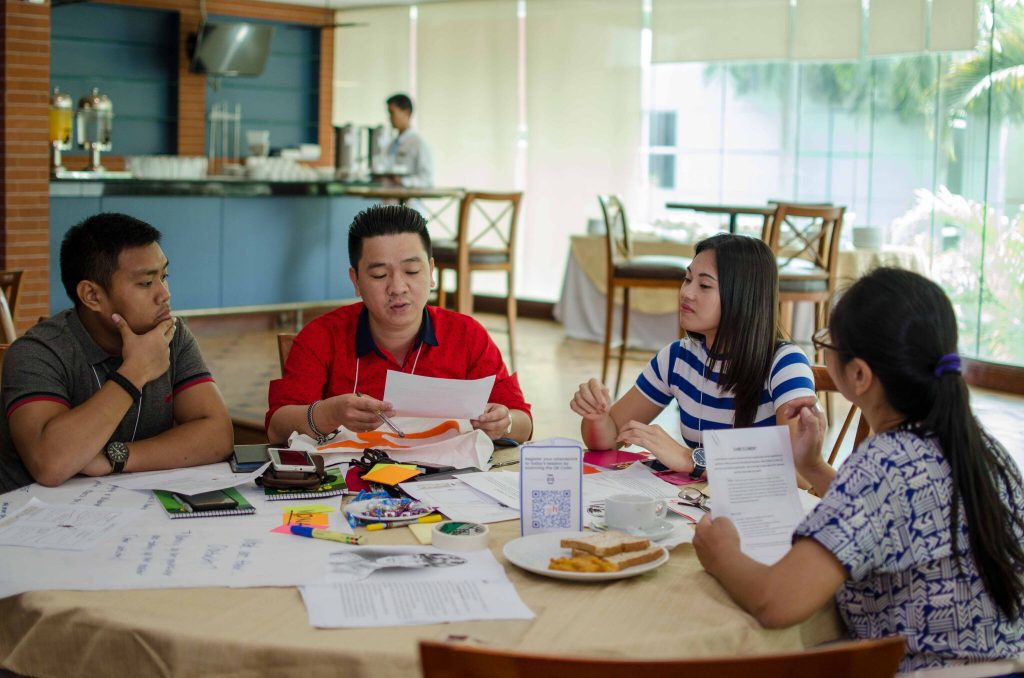1-2-4-All

Engage everyone simultaneously in generating questions, ideas, suggestions
Overview
The foundation of this fast idea-generating method is the involvement of all participants. People reflect on a topic, then work in pairs, then in groups of four, to share and build on ideas. Finally the whole group is engaged in a powerful brainstorm together. Participants access know-how and imagination almost without realizing and build strategies with their own ideas. Everyone contributes, and feels ownership over the ideas generated.
How to use it
- Structure learning sessions and group activities.
- Rapidly generate large numbers of ideas.
- Engage everybody in searching for answers.
- Enrich the quality of observations and insights before expressing them in the whole group.
- Build slowly toward a consensus or shared understanding.
- For feedback following a speech or presentation, as an alternative to asking, “Any questions?”
- Foster spontaneous conversation that starts after the topic of a meeting has been announced.
- Make progress in a stalled discussion.
- In place of a leader “telling” people what to think and do (often unintentionally) or for a group that tends to be excessively influenced by its leader.
How to apply it
Start:
Participants are asked a question in response to the presentation of an issue, a problem to solve or a proposal, “What opportunities do you see for making progress on this challenge? How would you handle this situation? What ideas or actions do you recommend?”
Setting:
An unlimited number of groups can participate in the activity. Participants are face-to-face when working in pairs and in groups of four.
Materials:
No chairs or tables needed. Notepads to record observations and insight.
Time/Steps:
- 1-2 minutes: Participants spend this time in silent reflection on a shared challenge, framed as a question, “What opportunities do you see for making this (aim) happen?”
- 5 minutes: Participants generate ideas in pairs, building on ideas from the reflection.
- 5 minutes: Ideas are shared in groups of four (similarities and differences are noticed at this time).
- 5 minutes: The facilitator asks each group to share one emerging idea, “Which idea stood out in your conversation?”
- Each group shares one important idea with all. Invite each group to share one insight but not to repeat insights already shared.
- Repeat this work cycle as needed.
How to adapt it
- If you want to spark more innovative thinking, start with “If our approach to ________ (refer to topic/challenge at hand) was totally obliterated last night, what parts would you re-establish?” and then again, “What new functions or attributes would you add?”
- Use sticky notes and brainstorming rules in Rounds 2 and 3.
- Link ideas that emerge to Design Storyboards, 25/10 Crowd Sourcing, Improv Prototyping, Ecocycle Planning.
- Go from groups of 4 to groups of 8, before broadening to the whole group, trying to achieve consensus across groups.
Case study
Title:
Tackling a high-level topic through out-of-the-box thinking
Activity:
Staff meeting ICTS
Contact:
Minori Hara, M.Hara@itcilo.org (ICTS)
Description:
At the beginning of the meeting, the staff members were told that the outlook of the meeting was going to be different than usual. The staff members had to think about ‘How to generate business value in ICTS?’ The topic was not related to the day-to-day work of the members and was future-oriented. By applying the 1-2-4-all methodology, participants with a more junior position or who were more introvert by nature, had the opportunity to participate on equal grounds with the senior members. The methodology allows participants to start individually and in small groups before presenting the ideas to the whole team.
Tips
- Firmly facilitate quiet reflection before paired conversations.
- Ask everyone to jot down their ideas during the silent reflection.
- Use bells for announcing transitions.
- Use a facilitator and an assistant to help record output if the group is large.
- Separate and protect generation of ideas from the whole group discussion. Set a rule of having one conversation at a time in the whole group.
- Set judgment aside, make ideas visual, be inventive.
- When you reach a level of stabilization or consensus, shift to another form of expression (e.g. improv, sketching, storytelling).




